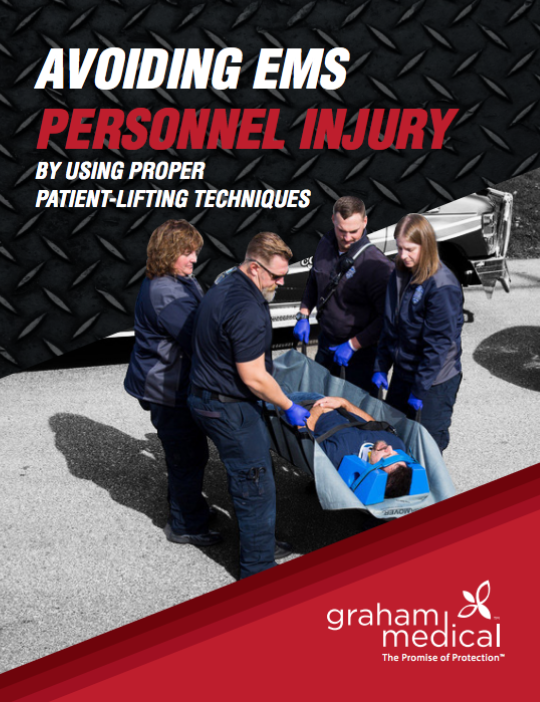Work-related injuries from physical overexertion, particularly lifting-and-carrying injuries, continue to be “just part of the job” for EMTs, First
EMS safety is paramount to ensure safe patient transport in unstable and unpredictable conditions. This eBook addresses key factors that contribute to EMS personnel lifting problems during patient transport and ways to reduce the risk of staff injuries. Read on to learn:
- safe lifting techniques,
- exercises to promote better lifting,
- important considerations, specifically, for EMS personnel,
- and tools First Responders can use to make patient transport easier and safer.

Download Your Copy Today!
Download your complete copy of this eBook by filling out the form.
You can browse and jump to different guide sections using the table of contents.
TABLE OF CONTENTS
1. Introduction
2. Lifting Problem Factors
3. Exercises to Promote Safer Lifting
4. Using Your Head When Lifting Patients
5. Specific Lifting Techniques
6. Critical Take-Aways
7. Making Lifting Easier
Introduction
Work-related injuries from physical overexertion, particularly lifting-and-carrying injuries, continue to be “just part of the job” for EMTs (Emergency Medical Technicians) and other professionals who lift and transport excessive weight.
Musculoskeletal disorders (MSDs), injuries and disabilities that impact body movement, is one of the more common group of problems EMS personnel encounter. According to the United States Bureau of Labor Statistics (BLS), work-related MSDs account for one-third of the reported causes of lost/restricted work time. For EMS personnel, lifting patients should be done ergonomically and generally requires multiple handlers to avoid overexertion.
Overexertion can be thought of as a particular subset of MSDs. This piece by the National Safety Council cites overexertion injuries as the, “#1 cause of nonfatal disabling work injuries”, and the, “#1 Cause of DAFW (days away from work)”. According to their data, 52% of overexertion injuries are to the back and 53% are due to lifting. This article goes on to say that, “Overexertion is an expensive problem. The costs to treat sprains and strains are rising and exceed the average of all cases.”
This NIOSH (the National Institute for Occupational Safety and Health) article on Safe Patient Handling and Mobility (SPHM) cites data from the BLS which indicates that “in 2014, the rate of overexertion injuries averaged across all industries was 33 per 10,000 full time workers. By comparison, the overexertion injury rate for hospital workers was twice the average (68 per 10,000), the rate for nursing home workers was over three times the average (107 per 10,000), and the rate for ambulance workers was over five times the average (174 per 10,000).” (our emphasis added)
They went on further to state that, “The single greatest risk factor for overexertion injuries in healthcare workers is the manual lifting, moving and repositioning of patients, residents or clients, i.e., manual patient handling.” (our emphasis added)
Lifting Problem Factors
MSDs can be minimized when you understand the factors that put your team at risk when lifting. This piece from the OSHA Technical Manual lists several factors that can be associated with back injuries alone.
- Reaching while lifting
- Poor posture-how one sits or stands Stressful living and working activities-- staying in one position for too long
- Bad body mechanics-how one lifts, pushes, pulls, or carries objects
- Poor physical condition-losing the strength and endurance to perform physical tasks without strain
- Poor design of job or work station
- Repetitive lifting of awkward items, equipment, or (in healthcare facilities) patient
- Twisting while lifting
- Bending while lifting
- Maintaining bent postures
- Heavy lifting
- Fatigue
- Poor footing such as slippery floors, or constrained posture
- Lifting with forceful movement
More specifically related to lifting injury risks for EMS personnel are factors such as:

In addition, while the Revised NIOSH Lifting Equation (RNLE), by Waters, et al, lists 51 pounds as the maximum lifting weight limit to prevent back injuries, this limit applies to inanimate objects only and not to patients or other persons. Dr. Waters authored a later piece entitled, “When is it Safe to Manually Lift a Patient?” in which he states, “For most patient-lifting tasks, the maximum recommended weight limit is 35 lbs.—but even less when the task is performed under less than ideal circumstances, such as lifting with extended arms, lifting when near the floor, lifting when sitting or kneeling, lifting with the trunk twisted or the load off to the side of the body, lifting with one hand or in a restricted space, or lifting during a shift lasting longer than eight hours.”
These “less than ideal circumstances” are the kind of situations that fire protection personnel, including paramedics and EMTs, encounter quite often in their professional pursuits, and which further decreases the optimal lifting load limit below the 35-pound maximum.
As indicated in the quotation cited above, these include:
- lifting with extended arms,
- lifting when near the floor,
- lifting when sitting or kneeling,
- lifting with the trunk twisted or the load off to the side of the body,
- lifting with one hand or in a restricted space, or
- lifting during a shift lasting longer than eight hours.
One way to help lessen the risk of these lifting injuries is to promote physical fitness with particular exercises that address the muscle groups included in the kinds of situations EMS personnel often find themselves.
Exercises to Promote Better Lifting
A few years ago the American Council on Exercise (ACE) and National Association of Emergency Medical Technicians (NAEMT) joined together to create a fitness guideline for EMTs, entitled, “Task Performance and Health Improvement Recommendations for Emergency Medical Service Practitioners”. This guideline outlines the need for specific work-related exercises for EMTs and presents specific exercises to address the various lifting situations in which EMTs often find themselves.
As indicated on EMS1.com, this fitness app with customized EMS workouts was designed by EMS1 columnist, Bryan Fass, for paramedics and EMTs. It is based on the NAEMT fitness guidelines referenced above and offers more than 1,000 online programs. Bryan also shared 3 exercises to avoid back injury listed below.

Using Your Head When Lifting Patients
EMS personnel are trained to lift with their legs, not their backs. In order to do this consistently and effectively, you must first engage your brain. This is what the Mayo Clinic says, “Before you lift a heavy object, think through your task.”. This is very good advice. This EMSWORLD article, titled “Lift With Your Head”, echoes that sentiment encouraging EMTs to “think outside the box”, and to plan lifting activities.
The very first thing to do is to think through the situation. When you have a 180-pound person in a bathroom, stuck between the bathtub and the commode, with a head, heart or breathing issue, the first inclination may be to expend whatever effort is necessary to get the patient to a safe place as quickly as possible. However, as an EMT, you do not want to put yourself, or your partner, in a situation that may result in a debilitating back injury, or put the victim in a, physically, more dangerous condition.
Train yourself to observe and assess situational requirements before you lift, then communicate with your other team members about the methodology to be employed. It may be difficult during crisis situations, when time is critical, but if consistently incorporated into your patient-lifting techniques, it can become routine and help avoid an overexertion injury.
Specific Lifting Techniques for EMS Personnel
There are a number of basic guides for proper lifting by EMS personnel and they all seem to emphasize the same thing, which is:
- Get as close to the person being moved as possible.
- Get a good firm stance with both feet even with each other about shoulder width apart.
- Squat down with knees and hips flexed and with the back straight.
- Get a good grip on the person to be moved or, preferably, on a supportive material under the person.
- Tighten the abdominal muscles and push down with the feet to tighten the thighs and hips.
A couple of things to pay attention to is that pushing is better than pulling when lifting. You push with the legs while you pull with the arms and back. So use the legs, not the arms and back. Another thing to consider is the vertical distance that the object, or person, is to be lifted. The greater the vertical distance, the height, to be lifted the greater the strain and potential for injury. When possible, place a sturdy material under the person to be moved, preferably with handles like the MegaMover® by Graham Medical, and use a drag technique with multiple handlers. This avoids lifting altogether. If lifting is required during transport, utilize multiple team members in the following fashion.
Each Member Should:
- Stand as close to the victim as possible
- Grab an appropriate length handle (of the MegaMover® Select if available), then
- with the upper torso straight,
- lean away from the victim, creating an open scissor appearance, which lifts the victim an inch or so off of the floor.
This does lift the patient off of the floor, but - as indicated by the Revised NIOSH Lifting Equation - does not create the muscle stress and strain required to lift waist high as with a rigid stretcher.
Critical Take-Aways
The hazards associated with lifting should be very apparent. According to the previously cited, EMS fitness guideline, a 2012 NAEMT report indicated that:
- EMS practitioners are seven times more likely than the average worker to miss work as a result of injury.
- Half of all EMS workers suffer back pain annually.
- One out of four EMS practitioners will suffer a career-ending injury within the first four years of service.
- Back injury is the most frequently cited reason for leaving EMS.
- Back injuries are often the result of cumulative wear and tear.
A few things need to be forcefully emphasized to EMS personnel when engaged in a situation that requires lifting.
- Always lift with a partner or, even better, a team of responders. (Don’t try to be a hero and lift solo)
- Always use proper lifting techniques and be sensitive to the 35 pound maximum weight limit for lifting.
- Lift as little as possible and keep the object as low as possible. (Don’t lift waist high if dragging or lifting an inch or two off the ground is possible)
- Use assistive devices whenever possible.
- When placing the patient on the gurney or transferring from the gurney to a hospital bed or ER cot, go head to foot rather than side to side.
Making Lifting Easier
While there are many assistive devices on the market to aid in lifting and moving patients, or victims, to a waiting ambulance, we are going to focus on the MegaMover® by Graham Medical.
The MegaMover® Transport Units actually include a family of models for use in varying circumstances as indicated below.

Key features and benefits of value to EMTs are that:
- All of the units are nonwoven and so resist leakage of bodily fluids through them.
- They are latex-free.
- The material is very strong, capable of holding 1000 pounds.
- They come with 14 handles for ergonomic lifting.
- Two of the handles are on the ends for ease of dragging.
- The units are now available with PowerGrip™ handles for added comfort and durability.
- They are designed and priced to be single-use only to avoid cross-contamination.
- They fold, weigh less than a water bottle and store easily.
Graham Medical is proud to be able to provide economical and effective devices to support the health and well-being of our emergency service personnel and we seek to identify other innovative ways to achieve that goal.

